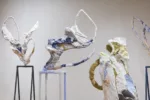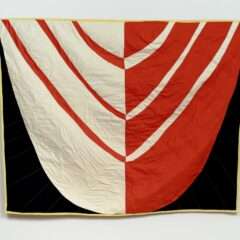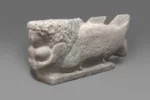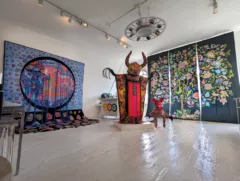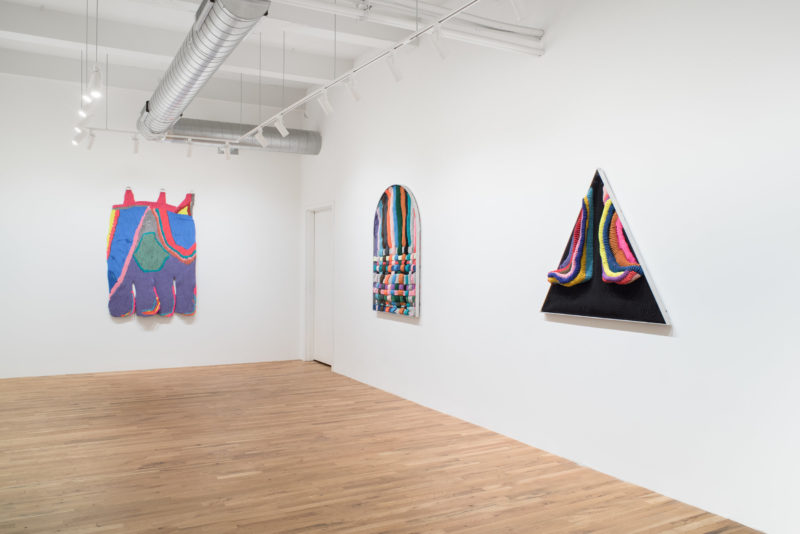
Artblog Readers may recall the enchanting work of multidisciplinary artist Jesse Harrod, whose two-person show at Fleisher/Ollman in 2019, alongside Lisi Raskin, garnered enthusiastic responses from art viewers and critics alike. Harrod has returned to Fleisher/Ollman, now as a represented artist, for a solo exhibition titled Tough Nut. The artist presents a range of sculptural works that teeter between textiles, paintings, fiber art and drawing. After completing a residency at the John Michael Kohler Arts Center and Kohler Co.’s Art/Industry program, Harrod has now added brass to their materials list. The resulting pieces are solemn totems amongst Harrod’s more exuberant textile works.
Throughout this collection of new work, Harrod references rugged landscapes, the curves and crevices of the body, and heavenly formations, while still maintaining a dedication to both abstract imagery and form. Harrod considers their strongest skill to be drawing, despite being a sculptural artist. “I feel like what I’m doing with the macrame is drawing,” Harrod tells me. “The rope is a pliable, linear element that is moving through space.” This kind of cross-dimensional language is not merely a poetic sentiment, it is a clarifying description of what unfolds before your eyes when witnessing Harrod’s work.
Logan Cryer: How did you step into your creative practice?
Jesse Harrod: I definitely came from a very creative family that encouraged making and expression through making. I had an incredibly hard time in school. I’m very dyslexic and have ADHD, and I was held back for grade three and also was very naughty. So art and making was one of the ways that I could express myself as a child, and that was encouraged. I was also very sick as a kid because I was born with a heart problem, a heart problem that was complicated and hard to figure out what it was until I was about 16. So I spent months at a time in the hospital.
That coupled with being hyperactive is not a great mix. So my father would draw images on burlap and then I would embroider those images. He was very good at figuring out ways for me to be active and to be creative while being stuck in a hospital bed for months at a time. My parents were very involved in politics and activism in South Africa. That era had a lot of radical theater and performance and music. So I grew up around people like that. It was a very safe space to be creative.
But my sister was a much better artist than I was. She was gifted academically and was put into gifted programs and a very good artist. I’ve read that if one sibling goes down a path, it kind of closes that path for the other sibling. So I went a different path. I initially started off as a social worker. I dropped out of high school and I went back to South Africa and lived with my brothers and sisters. Eventually I came back to Canada and went to college and studied community development and crisis counseling while my sister was becoming an artist.
And then for all sorts of reasons that we don’t need to get into in an interview, my sister stopped making art. In a weird way, that gave me permission to then decide to go back to art school. Before I went to art school in my twenties, I was doing community-based arts projects. So I was working mostly with immigrants, new immigrants and HIV positive youth doing fairly large scale art projects that were amazing. But through doing that, I was like, wait, I want to make art. So then I went back to NSCAD in Nova Scotia and did my BFA and then my MFA. So I kind of came late to it, but I think it was always there. It just got overshadowed by some of the life challenges.
LC: How old were you when you got your BFA?
JH: I was 33, in my early thirties.
LC: I think there’s something to be said about the older undergrad student in art school. It seems you use your time better and you are more focused.
JH: There’s good and bad. I was really young in many ways because I also came out really late. So I came out when I was like 29. I was a kid in a candy store because I had just come out of the closet. I had left a serious relationship, moved to another place. I was like a 13-year-old.
LC: So how soon after your BFA did you do grad school? Was that right after?
JH: It was pretty close. I think when my mom died, the promise I made to myself was that I would run towards the things that scared me. I wouldn’t play it safe and I wouldn’t allow myself to feel insecure. Before she died, I had never any intention of going to grad school because that just seemed way too serious and competitive. And then when she died, I was like, “I’m going to fucking do this.”
I applied to schools predominantly in England because that’s where most Canadians go to grad school. And I got into all the schools I applied to. And then I met this incredible curator in Toronto at the Textile Museum named Sarah Quinton, who I think retired recently. And she came to a show that I was in and I said, “Where do you think I should go to grad school?” And she said, “Oh, you should go to The Art Institute of Chicago (SAIC).” And so I applied and I went for the interview. I had already agreed to go to Chelsea in London but, I went to the interview and I was like, “No, I belong here. This makes more sense.”
LC: And you stayed in Chicago for a while after that, right?
JH: I was there for four years and then I was on these short little visas that would only allow me to teach. So to be able to make a living, I would teach at three different schools. And so I would teach at SAIC and then I would get on the train and go north to Racine, Wisconsin for a three-hour train ride, teach a class, then come back at one in the morning and then get up at three in the morning and take a train to the south side of Chicago, teach at the University of Chicago. It was craziness.
I worked so fucking hard. I worked so hard and I was so broke. I was so skinny because I had no money. I would just go to openings and bring Ziploc bags and pocket all the food. And any friends I had that had money I would just be like, “Can I come over for dinner? I’m really hungry.” It was rough because I was working really, really hard and I was trying to maintain a studio practice and I didn’t have a ton of friends because I was working so hard. It was just a very isolated time. But at a certain point, I couldn’t get any more of these visas. And I was like, “I got to get a fucking full-time job if I want to stay in this country.” And so I applied for one in Virginia and they said, “Yeah, come and we’ll give you a visa or a green card, but you have to stay two years.” I went to the hellscape of Virginia, and I stayed for two years, got my green card and then left immediately. But as much as it was such a culture shock, I learned so much there.
LC: What did you learn?
JH: Well, I learned about America. I realized how much in Chicago, I was in this little liberal white bubble and ostensibly going to the South, I was like, “I don’t know anything about Jim Crow. I don’t know anything about slavery. I don’t know anything about this country.” I never studied American history. It wasn’t a place that mattered to me growing up. I didn’t know what redlining was. I knew nothing. And I was dealing with really racist people and I was like, “I got to learn about this place if I’m going to live here.” I was really isolated and people were really unfriendly and really not into me being queer and not into [my spouse] Leigh at all.
My students had never heard of feminism, and they all just wanted to make Confederate flags on the loom. And at first I was like, “Okay, you can make a Confederate flag.” I didn’t even know what that was. So I was like, “I got to learn about these images and symbols.” And that then forced me to learn about the history of Canada too, in ways that I didn’t understand. I didn’t realize that there had been slavery in Canada. So it was eye-opening. And so I was teaching my students about early feminism in the Fiber Movement. And then I was like, “I’m going to teach you guys how to macramé.” And that’s how I started macraméing.
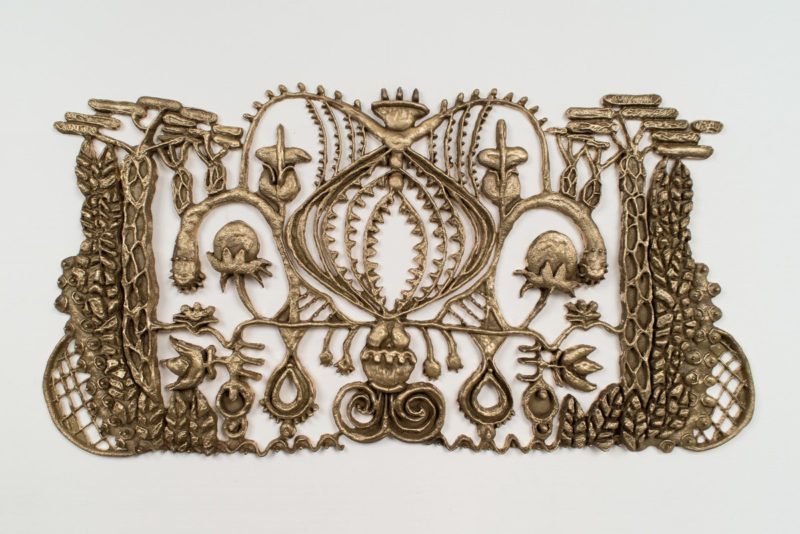
LC: Oh wow! So what happened? You just fell in love with macramé?
JH: Yeah. I had never wanted to macramé because I sort of thought it spoke to my mom’s kind of Second Wave ‘70s feminist aesthetic. At that point I was newly out and anything that sort of referenced Second Wave feminism, I was like, “This is fucked up.” But in teaching those kids how to do it, I started playing with it and realized how I could create form with this really simple technique.
I was so lonely, I would drive around on the weekends and go into random shops and there were all these survivalist shops and preppers. I would buy paracord because they sold it in all these different colors. And then I started playing with the paracord and that was how I got into working with paracord and macramé.
LC: I didn’t know that your time in Virginia was such a crucial point in your life.
JH: It really was. It really was a game changer. It was really, really, really hard. People were so horrible. There were a handful of people who were amazing, but people would scratch my car, key my car, and throw things and yell at me. And I’d go to faculty meetings or faculty parties and no one would talk to me. I was in Virginia for Obama’s second term election and they’d have effigies of Obama hanging from nooses on street corners and no one would do anything about that. I left there in 2016 and came to Philly. I remember everyone I met in Philly was like, “There’s no way that Trump is going to win.” And I was like, “No, I lived in Virginia. Trump’s going to win.”
LC: Something I am curious about is how it is that you’re actually able to balance teaching and making.
JH: When you get hired for a teaching job at a research institution, which is what Tyler is, our value at Tyler’s based on our ability to be an artist. The whole system is fucked. But I only get a raise or get tenure if I have an art practice. That first five years that I was at Tyler, when I lived on Hope Street, all I did was go to work, go to the studio. I just fucking got to make it work, not because I was gallivanting, but just because I was like, “This has to be the priority.” I knew that I didn’t want to be an artist that relied on sales. I didn’t want my work to be dictated by a market.
Because of my health issues, I have to have health insurance. I’ve had eight heart operations. I have to have health insurance. I knew I had to have tenure. If you go up for tenure and you don’t get it, your career is over. So that first five years I worked so fucking hard. But I’m lucky, Logan, because I’m not very social. The people I love, there’s not a lot of them, but I love them hard. The people who I care about, I care so deeply about, but I don’t really like going out. I’m not really a drinker. I hate getting dressed up. I’m not social. I would always much rather be in my studio pretty much than anything else in the world.
LC: Do you encourage a similar kind of work ethic in your students?
JH: I’m pretty compulsive. And because I’m hyperactive in the ADHD spectrum, the hyperactivity is the main thing that I embody. And I think there was a moment before COVID where, particularly amongst the grad students, there was this push towards self-care and balance. And I think all of that’s bullshit. I think this notion of balance is a way to make people feel bad about themselves. I think it’s a strategy for capitalism to further the self-hatred that it promotes for women.
LC: Because you’ll never actually get there?
JH: You’ll never have balance in a society. It’s absolutely impossible. I don’t have kids, but how does someone with kids and a job and a partner and friends … you can’t do it all unless you’re fucking loaded. I think it’s a cruel mythology that the media has created. You’re looking for some kind of system or situation where you can have a balance in a country that is selling you a myth and it’s not going to happen. The art world is so about privilege. If you want to be successful and you don’t have family money, the only way you’re going to get there is if you make amazing work and you fucking work your ass off. You got to be strategic, otherwise it’s never going to happen. So do I talk to my students about that? I am honest about my narrative and my experience, and then I leave it up to them to decide how to approach it. But I don’t know a lot of people who work very hard.
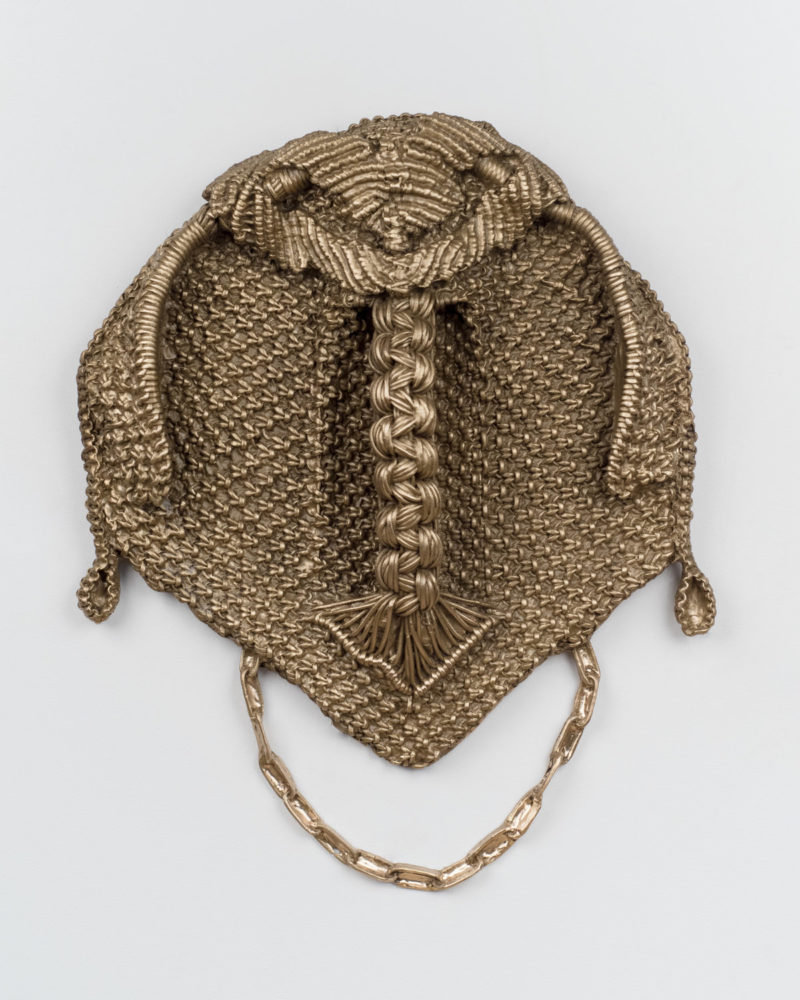
LC: I’m curious if you feel like there are common misconceptions about your work and what those are.
JH: I suppose the biggest misconception, which isn’t that prevalent for me, is that I’m a fiber artist. I don’t identify as a fiber artist. If I was really honest, drawing and painting is a thing that I think I’m probably best at, but it’s not the best way for me to explore my creativity. But it is where I think I have the strongest skill. There are some people who put me in this fiber world, but I don’t have a history of showing in a fiber context. I do think the one thing that I’ve noticed in the last couple of years is that there’s an expectation of what I’m going to produce. And if I make something that’s outside of that, then it’s either like, “No, you can’t show that,” or “That’s not on brand.” No one has actually said that, but that’s the insinuation.
LC: Do you feel like working with Fleisher/Ollman, they haven’t given you more permission to be expansive in terms of the diversity of work that you’re showing?
JH: Yes. Working with them is one of the best things that’s ever happened in my life. Yeah. Working with Alex, I feel loved and supported and encouraged and respected in a way that very few other galleries that I’ve worked with have achieved. Yeah. I think they’re a really special group of people.
Jesse Harrod, Tough Nut, at Fleisher-Ollman Gallery, through March 11. Conversation with the artist in the gallery, March 11, 2 PM. See more works at the artist’s website.


